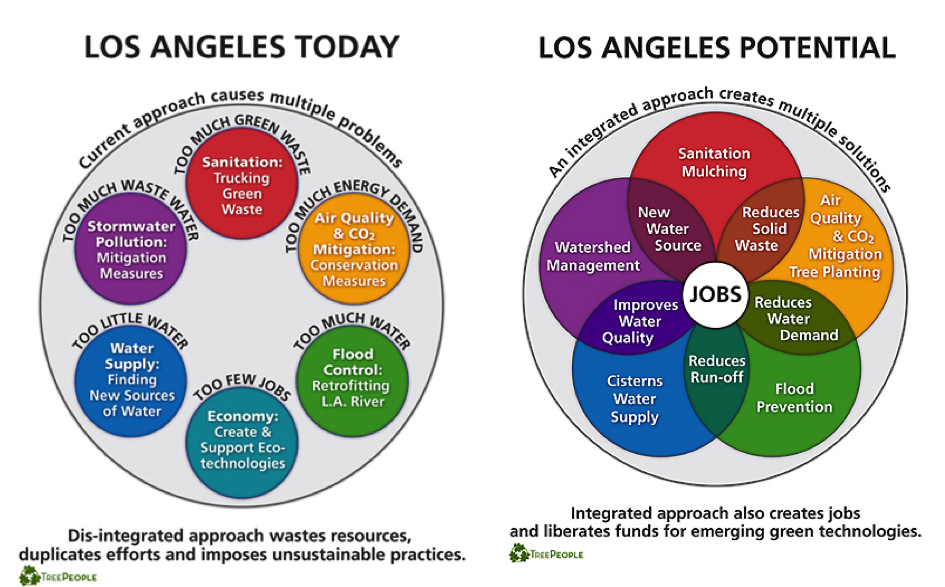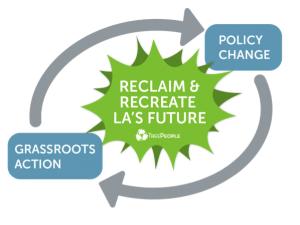Each week, TreePeople is out in the neighborhoods and surrounding mountains of Los Angeles, planting and caring for trees and native plants to ensure that our city has a growing, thriving urban ecosystem. But that’s not all we do – every day, we’re also working with agencies and policymakers at the city, county, state, and federal levels to enact strong policies to support creating a 21st century infrastructure for a water-resilient LA.
As Deborah Weinstein Bloome, TreePeople’s Director of Policy, explains, policy work “has been part of our DNA from the beginning,” largely under the guidance of our founder and president, Andy Lipkis. About fifteen years ago, our policy work expanded when we launched the T.R.E.E.S. project – that is, the Trans-Agency Resources for Environmental and Economic Sustainability. Through our work on multiple demonstration sites, creation of a cost-benefit analysis, research, and design charrettes, including architects, government officials, and engineers, we proved that it was socially, economically, and technically feasible “to design our urban landscapes as functioning mini-watersheds.”
Much of TreePeople’s core policy work continues from the pioneering work of the T.R.E.E.S. project. In fact, the first part of this acronym, “Trans-Agency,” set the stage for our continued focus on increasing collaboration and integrated management among and across government agencies that are responsible for different parts of our ecosystem. As the images below help illustrate, TreePeople believes that increased collaboration and integration of our government agencies leads to more efficient management of our ecosystem. We’ve been building our expertise on these issues for years, and soon we’ll be putting some of our knowledge into a formal report on government agency integration on water issues.
TreePeople’s policy work also focuses on pursuing policies, laws, and incentives to promote progressive 21st century methods for transforming LA into a climate and water-resilient region. In particular, our policy work’s focus on increasing LA’s local water supply, and particularly on ways to capture stormwater, has led to significant efforts by the region to increase local capture. One of our recent collaborative successes – this one with the Los Angeles Department of Water and Power – has been the creation and launch of the City of LA’s’ first ever Stormwater Capture Master Plan.
Because we feel it’s important to bring our policy work to the world rather than letting it quietly occur in the background, we launched a Policy Department, headed up by Deborah, several years ago. Our Policy Department regularly works with and advises local agencies that have a huge impact on our local water policies, such as the Los Angeles Department of Water and Power, the Los Angeles Bureau of Sanitation, and the LA County Department of Public Works, to create environmental policies and programs that work for LA.
In the next month, we’ll be releasing two reports on recent projects: one focusing on how government agencies can better collaborate and integrate in order to more efficiently manage our water and ecosystems; and a second that explains how we’ve worked with the Los Angeles Unified School District and other local agencies to find ways for local schools to capture more water on their campuses. Especially during the drought, it’s essential that we’re working to capture and save every drop of water that comes our way, and strong policy helps us set up the infrastructure and incentives so that we’re ready when it finally rains.
And though TreePeople is primarily a local organization, our policy work isn’t limited to the local level. We’re currently working at the regional, state, and federal levels to break through some of the policy, programmatic, and funding barriers that are keeping the region from investing in projects to get us through this drought and prepare us for a new water reality in LA. Plus, some of our work is international: this October we’ll be leading a policy delegation to Australia focusing on the lessons Australians learned from their Millennium Drought. When we come back, we’ll be working with policymakers to transfer the most appropriate policies and technologies to LA to help us survive this current drought and prepare us for the future.
All this is part of our “bottom-up, top-down” approach, illustrated in the graphic below. As Deborah points out, “we can’t achieve our goals of transforming Los Angeles with DIY and grassroots work alone”; we also have to work with agencies and policymakers to “create the support and mechanisms to incentivize people to make the necessary changes.” Ecosystems don’t work in a linear fashion, and neither should we. Working together – at all parts of the chain – we can build a sustainable, green LA.



